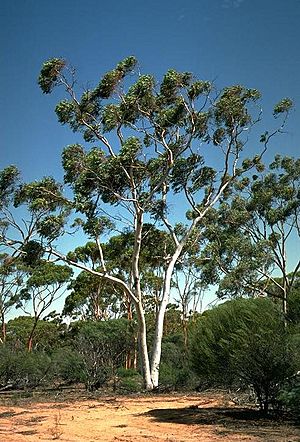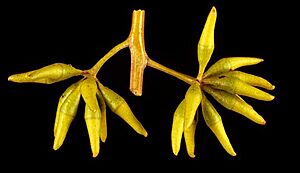Wheatbelt wandoo facts for kids
Quick facts for kids Wheatbelt wandoo |
|
|---|---|
 |
|
| Scientific classification | |
| Genus: |
Eucalyptus
|
| Species: |
capillosa
|
The Wheatbelt Wandoo, also known as Mallee Wandoo (its scientific name is Eucalyptus capillosa), is a special tree or bush found only in Western Australia. It has smooth, grey bark, which can sometimes look pink or pale orange. This plant has leaves shaped like a spear or an oval. Its flower buds look like spindles and grow in groups of nine to thirteen. When they bloom, the flowers are white. After flowering, it produces fruit that looks like a barrel or a cylinder.
Contents
What Does Wheatbelt Wandoo Look Like?
The Wheatbelt Wandoo is a tree or a type of bush called a mallee. It usually grows up to 12 meters (about 40 feet) tall. It has smooth, grey bark that can sometimes be powdery. You might even see pink or pale orange patches on its bark!
Leaves and Flowers
- Young Leaves: When the plant is young, its leaves are shaped like a spear. They are a dull blue-green color and measure about 40-85 mm long and 20-45 mm wide.
- Adult Leaves: As the plant grows, its leaves become a dull green on both sides. They can be long and narrow or oval-shaped, about 70-125 mm (3-5 inches) long and 10-22 mm (less than an inch) wide. Each leaf has a stem (called a petiole) that is 10-27 mm long.
- Flower Buds: The flower buds grow in groups of nine, eleven, or thirteen. They are shaped like a spindle, about 8-16 mm (less than an inch) long.
- Flowers: The Wheatbelt Wandoo blooms from December to May, and its flowers are white.
- Fruit: After the flowers, the plant produces fruit that looks like a cone or a barrel. These fruits are about 6-8 mm (less than an inch) long and 4-6 mm wide.
The Wheatbelt Wandoo is very similar to another tree called Eucalyptus wandoo. However, you can tell them apart because the Wheatbelt Wandoo has hairy seedlings and its adult leaves are green, not blue-green.
How Wheatbelt Wandoo Got Its Name
The Eucalyptus capillosa was first officially described in 1991 by two botanists, Ian Brooker and Stephen Hopper. They found a sample of the tree near Merredin.
The scientific name capillosa comes from a Latin word that means "hairy." This name was chosen because the young plants (seedlings) of this tree are hairy!
Different Types of Wheatbelt Wandoo
Brooker and Hopper also identified two different types, or subspecies, of Eucalyptus capillosa:
- Eucalyptus capillosa subsp. capillosa: This type is a small to medium-sized tree.
- Eucalyptus capillosa subsp. polyclada: This type is a mallee, which is a bush that grows up to 6 meters (about 20 feet) tall.
The name polyclada comes from two Ancient Greek words: polys, meaning "many," and klados, meaning "branch" or "stem." This name describes the mallee type, which has many branches.
Where Wheatbelt Wandoo Grows
The Wheatbelt Wandoo (subspecies capillosa) is found in the central and eastern parts of the wheatbelt region in Western Australia. It likes to grow in open areas with low bushes, mainly east of towns like Pithara, Kellerberrin, and Corrigin.
The Mallee Wandoo (subspecies polyclada) grows on gravelly slopes. You can find it in the central wheatbelt, stretching from Pithara to areas near Hyden and Lake Grace.
These trees often form open woodlands where many different types of plants grow underneath them. Other trees you might see growing alongside the Wheatbelt Wandoo include the Salmon Gum (Eucalyptus salmonophloia), the Gimlet (Eucalyptus salubris), the York Gum (Eucalyptus loxophleba subsp. loxophleba), and Eucalyptus transcontinentalis.
Conservation Status
The Western Australian Government's Department of Parks and Wildlife has classified this eucalypt as "not threatened." This means it is not currently in danger of disappearing.



